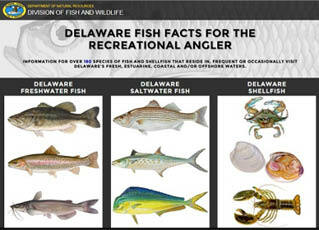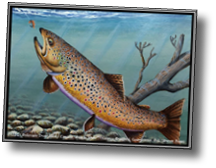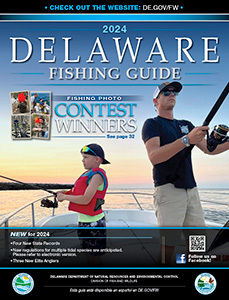Fish & Wildlife Directory
State of Delaware
John C. Carney Jr.
Governor
Delaware Department of Natural Resources and Environmental Control
Shawn M. Garvin
Secretary
Division of Fish & Wildlife
Patrick J. Emory
Director
Advisory Council on Wildlife & Freshwater Fish
Steve M. Kendus,
Chair
Garrett L. Grier, Jr.,
Vice Chair
Raymond F. Burris
John Neal Dukes
Nathan R. Hudson
Joe C. Johnson
Steven M. Kendus
Dale R. Scuse
F. Thomas Unruh
Advisory Council on Tidal Fin Fisheries
Dr. Dewayne Fox,
Chair
P. Wes Townsend,
Vice Chair
Brian Hoffecker
Mike Cerchio
Bernard L. Pankowski
Joseph A. Smith
Matthew Tull
Advisory Council on Recreational Fishing Funding
Bernard L. Pankowski,
Chair
David A. Russell,
Vice Chair
John Burbage
Eric B. Burnley, Sr.
Richard Carlisle
Loren C. Evans
Hon. Ronald Gray
Hon. Gerald Hocker
Ronald L. Horton
Advisory Council on Shell Fisheries
Leonard Voss, Jr.,
Chair
Jordan Giuttari
Edward Hale, Jr.
Richard S. Hand, Jr.
Desmond Kahn
Paul Satterfield
Directory
Division of Fish & Wildlife - www.fw.delaware.gov
Fisheries Section, Dover - (302) 739-9914
Fisheries Field Offices
Little Creek - (302) 735-2960
Aquatic Resources
Education Center - (302) 735-8652
Recreational Fishing Licenses - (302) 739-9918
Fish & Wildlife Enforcement Section
New Castle County - (302) 836-4682
Kent County - (302) 739-6139
Sussex County - (302) 855-1901
24-hour hotline (KENTCOM)
for reporting violations,
problems - (800) 523-3336
Boating Safety - (302) 739-9915
Ramp Certificates - (302) 739-9916
Boat Registration - (302) 739-9916
General Information
Freshwater Trout Program - (302) 739-9914
Non-tidal Fishing - (302) 735-2960 / (302) 735-8650
Tidal Fishing - (302) 739-9914 / (302) 735-2960
Fish Consumption Advisories - (302) 739-9914
Division Public Health - (302) 744-4546
Artificial Reef Program - (302) 735-2960
Fishing / Boating Access Areas - (302) 739-9914
Clamming - (302) 735-2960
Shellfish Health & Safety,
Closures - (302) 739-9939
Crabbing - (302) 735-2960
State Record
Fish Verification - (302) 735-2960 / (800) 523-3336
Fish Kills & Environmental
Emergencies/Complaints - (800) 662-8802
Fish facts
Hey, having trouble identifying your catch? Want to know a good bait to use to catch a certain species? Need to find out what the current state record is for a species? Check out our “Fish Facts” page with loads of helpful information on over 180 species of fish and shellfish you can catch in Delaware waters. Just type fishspecies.dnrec.delaware.gov in any browser and click on a category. Many folks keep it bookmarked on their smartphone for quick access. Enjoy!

Fishing License Plates
Purchase a Delaware recreational fishing specialty motor vehicle license plate to show your passion and support for sport fishing in Delaware. There is a one-time purchase price of $95, $80 of which will be used to promote recreational fishing in Delaware and to support fisheries research, habitat restoration, and fish stocking. The new fishing plates can be ordered by mail. An application and ordering instructions are available online at https://tinyurl.com/DEFishplate.

Collecting Stamps
If you are interested in collecting trout or waterfowl stamps, please contact the Division at (302) 739-9918 or visit our website at: http://de.gov/troutstamp.

Recreational Gill Nets
Gear and seasonal restrictions apply to recreational gill nets and anyone obtaining a permit will be informed of these restrictions. In addition, during 2024, all recreational gill nets must be removed from the Delaware Bay and Ocean on the following dates: May 1-8, May 11-13, May 18-20, May 25-27, June 1-3. June 8-10, June 15-17, June 22-30 in order to reduce weakfish mortality rates as required by the Atlantic States Marine Fisheries Commission’s Weakfish Management Plan. Each closure period begins at 12:01 a.m. on the first day and ends at midnight on the last day. No striped bass caught in recreational gill nets may be retained at any time.
Shellfish Aquaculture — Inland Bays
Anglers and boaters should be aware that shellfish aquaculture leases are established in Delaware’s Inland Bays. Leased areas may contain submerged or floating aquaculture gear. Although anglers may fish in these areas, it is unlawful to anchor on a leased area or tie a vessel to any lease markers or gear. It is also unlawful to harvest any cultured or wild bivalve shellfish from the lease sites or associated navigation corridors. Shellfish aquaculture leases are presently located in the areas indicated on Fishing & Clamming Maps; however, other areas may be leased in the future. For an interactive map of the leased areas, or more information on the program, please refer to https://dnrec.alpha.delaware.gov/fish-wildlife/fishing/shellfish-aquaculture/.
Have You Seen a Sturgeon Lately?
Have You Seen a Sturgeon Lately? If you find a dead sturgeon please report it immediately by email at [email protected], by calling: 302-735-8663, or scanning the QR code to the right. Don’t forget to include an exact location and contact information in your message.
Access Point Angler Intercept Survey (APAIS)
The most critical responsibility of Delaware Division of Fish and Wildlife’s (DDFW) Fisheries Section is sustainably managing our fisheries to keep fishing in Delaware great. Good management depends on good data, so the Fisheries Section is always looking for ways to improve its data collection. To that end, the Fisheries Section, working with the Atlantic Coastal Cooperative Statistics Program (ACCSP), will conduct the Access Point Angler Intercept Survey (APAIS). This survey is a critical component of the Marine Recreational Information Program (MRIP), used to estimate the number of fish caught and harvested by recreational anglers. MRIP counts and reports marine recreational catch and effort, using in-person, telephone, and mail surveys. The Fisheries Section believes that a Delaware APAIS conducted by DDFW will result in improved data quality and greater stakeholder confidence in that data. We anticipate that our involvement in conducting the APAIS will:
- Improve data quality and efficiency of data collection;
- Maximize angler participation; and
- Give Delaware anglers a bigger stake in the recreational data and the data collection program.
What to expect when interviewed
The intercept survey is conducted by DDFW fisheries personnel at fishing access points along the Delaware coast. Saltwater anglers returning from a fishing trip may be asked to participate in the dockside survey. The interview, which only takes a few minutes to complete, consists of two major sections:
- A background portion that addresses fishing mode (private boat, shore, or charter boat), gear type, number of anglers, hours spent fishing, general area fished, whether anglers were targeting specific fish species, and the anglers’ county and state of residence; and
- The latter portion which focuses on the anglers’ catch. We ask questions pertaining to the species and number of fish released as well as those fish kept. For released fish, we collect information on whether they were used for bait, or released alive or dead. We also ask to measure and weigh fish retained by the anglers
The intercept surveys are conducted by DDFW fisheries personnel at fishing access points along the coast of Delaware.
By participating in this survey, you’re helping keep recreational fisheries sustainable.
- You’re our “eyes and ears” on the water — what we learn from you is critical to understanding the health of our fisheries.
- You’re on the front line of conservation. You can have a real impact on our waterways and how they’re managed.
- Your input helps ensure that regulations are working and that our fish populations can support recreational fishing for future generations to enjoy.
Delaware has fourteen permitted artificial reef sites in Delaware Bay and along the Atlantic Coast. Development of these sites began in 1995 and will continue. The Delaware Reef Program is one part of a comprehensive fisheries management effort and is designed to enhance fisheries habitat, benefit structure-oriented fish, and provide fishing opportunities for anglers.
The site charts in the free reef guide show where reef materials have been deployed since 1995. The reef program uses DGPS (Differential Global Positioning System) to accurately place materials on site. Locations (latitude - longitude) noted for each site indicate the position of deployments of reef material from an anchored barge. In the case of large, concentrated reef deployments, a latitude or longitude range, may be given such as: N 39 15.377’-402’. This indicates material occurs between 39 degrees, 15.377 to 15.402 minutes north latitude. Due to variability between DGPS receivers, slight variations in readings may occur. It is suggested you use your GPS and a good fathometer to locate reef structure, then note the coordinates on your own GPS. You can view the reef guide online at dnrec.alpha.delaware.gov/fish-wildlife/fishing/artificial-reefs/ or contact the Fisheries Little Creek field office for a copy (302) 735-2960.
The Division of Parks and Recreation surf fishing beaches are located in Cape Henlopen State Park, Delaware Seashore State Park and Fenwick Island State Park, and on Beach Plum Island. Special restrictions and regulations apply to these areas. For more information contact the Division of Parks and Recreation, (302) 739-9220.
In order to drive a vehicle on a designated State Park beach, a SURF FISHING VEHICLE PERMIT is required. Only four-wheel drive vehicles with a minimum ground clearance of seven inches that are licensed to operate on public roadways are eligible for Surf Fishing Vehicle Permits. Permit holders must be actively engaged in surf fishing while on the beach. Permits are available at State Park offices, various license agents, and at the DNREC main office in Dover.
Purchasers of Surf Fishing Vehicle Permits will receive additional rules and safety requirements. The revenue collected from these permits supports the management of seashore State Parks and beaches. None of the proceeds from these permits go towards fisheries management programs or fishing access projects conducted by the Division of Fish and Wildlife.
Clean Water
How’s My Waterway
How’s My Waterway (www.epa.gov/mywaterway) helps users quickly find information on the condition of their local waters using a smart phone, tablet, or desktop computer. This tool provides results within seconds using EPA’s water quality assessment data. Check out the condition of your local waterbody today!

Invasive Species Alert
It is unlawful for any person to transport, purchase, possess, or sell walking catfish (Clarius batrachus), the white amur or grass carp (Ctenopharyngodon idella), live northern snakehead fish (Channa argus), blotched snakehead fish (Channa maculata), blue catfish (Ictalurus furcatus) or flathead catfish (Pylodictis olivaris) without the written permission of the Director.


